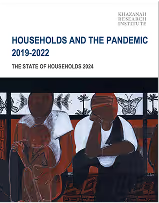
How will the landscape of employment in Malaysia change in facing the future of work brought about by rapid progress in technology? This essay explores this question by drawing on existing work in the literature and assessments on the latest developments in Malaysia's labour market and the economy in general.
The landscape of employment in Malaysia is expected to change in a number of consequential and inter-related ways as we move into the coming decades. Polarisation in employment will continue to occur, with more jobs created for both ends of the skill spectrum as labour-saving technology continue to displace middle-skilled jobs. Rapid growth in technology-enabled digital platforms, on the other hand, will continue to intensify the rise of independent work - changing the very nature of employment away from the traditional full-time fixed employment. Finally, as per our experience in the past, the evolving structure of the Malaysian economy particularly with the continued stagnation in manufacturing and the rapid growth of new modern services will also reshape the sources of job creation for the Malaysian workforce.
These changes are in turn underpinned by two salient trends. Firstly, the fast pace of progress in technology would most likely lead to more rapid cycles of obsolescence and renewal in the types of work and industries available - Malaysians entering the workforce now can expect to switch jobs more frequently over their lifetimes. Secondly, together with the first trend, with the rise of independent work, the traditional employer-employee relationship could be eroded, which would simultaneously provide greater autonomy to workers but remove the stability of more traditional full-time fixed employment. In responding to these trends, a serious consideration of inculcating lifelong learning for all, and the development of relevant social safety nets that do not compromise on the flexibility and dynamism of modern jobs and the security of traditional employment are essential.
In facing this future, it is essential to recognise that the change in the landscape of employment will be uneven - it will not be unequivocally positive for everyone even if it is better for the Malaysian economy overall. Equally important is to realise that we are not passive observers of the change that is coming - just as how technology will inform what is possible for the future of work, so will our responses to these possibilities shape the contour of the changing landscape of employment.
1. Introduction
In 1921, almost seventy per cent of the working population in the Malay peninsula was employed in agriculture by far the largest economic sector of the time. Now, almost a century later, this share has dropped to only twelve per cent. Instead, eighty per cent of the Malaysian workforce is currently categorised in the broad economic sectors of services and manufacturing. This change reflects the significant structural transformation of our economy over the decades, which in turn was shaped by our increased integration to the changing global economy, the adoption of technology, and the outcome of our policies for development.
As we move into the future, we can expect the structure and nature of employment in Malaysia to continue to change. But this time, the pace of change will likely be significantly faster than what we have ever experienced before. Unprecedented advances in artificial intelligence (AI), robotics and many other breakthrough technologies, together with new emerging business models enabled by these technologies, and the continued progress in information and communications technology (ICT), has the potential to drastically reshape the economy, upset existing industries, and fundamentally alter the landscape for employment for the country.
How ready is Malaysia in facing the future of work brought about by the rapid improvement in automation technologies and the continued rise of the platform economy? Drawing on existing work in the literature, this essay explores this issue in three parts. The first part is on the changing type and nature of jobs in Malaysia, with emphasis on the technological potential of automation in shaping the future of work on one hand, and the rise of independent work enabled by new technologies on the other. The second part examines the future of jobs in Malaysia from the context of the changing economic sectors, focusing on manufacturing and services. The third part discusses the broader policy implications arising from the changes discussed in the first two parts.
Part One: The Changing Type and Nature of Work
2. Technical possibilities the potential for automation
It is likely that we are now at the tipping point of another great technological leap, brought about by a confluence of technological advances most consequential of which is AI. The field of AI has achieved significant progress in recent years, underpinned by the use of machine learning in which computers improve their perception, cognition, and action with experience, without explicit programming by humans.
Advances in robotics, machine vision, natural language processing, human-computer interactions, and many other sub-fields made possible by the progress in Al has made it technically possible for a vast variety of tasks currently done by human labour to be undertaken by machines. On one end of the spectrum, jobs that will most significantly be affected by automation are those mainly involving repetitive routine tasks. On the other end, jobs which require three types of skills - 1) complex perception and manipulation, 2) creativity, originality and initiative-taking, and 3) social intelligence and personal engagements will be those that are most difficult to automate.
In the next two decades, it is estimated that between 11 and 54 per cent of the current jobs in Malaysia could be significantly affected by automation that is, either fully displaced by technology or with their nature considerably changed. Four out of five of these jobs are middle-skilled, while the remaining ones are low-skilled. Malaysians will be most affected as ninety per cent of all middle-skilled jobs are held by Malaysians.
Before proceeding further, it is useful to highlight a few points on the interpretation of these estimates. Firstly, these estimates are based on the technical potential of automation. But just because a task or job can be automated, it does not mean that it will be. That depends on many other non-technical factors. The speed and extent of the adoption of automation technologies, and thus the proportion of jobs that would be displaced would depend on labour market conditions and potential economic benefits that could be derived from adopting automation. Secondly, it is crucial to recognise that tasks that are not substituted by technology will most probably be complemented by it.
3. Vanishing middle - job polarisation with distinctions
In the past few decades, the introduction of modern labour-saving technology has been one of the main factors contributing to the phenomenon of job polarisation in the advanced economies the automation of semi-skilled routine tasks has led to simultaneous employment gains in high-skill, high-wage jobs on the one end, and low-skill, low-wage jobs on the other end, at the expense of middle-skill, middle-wage jobs.
For Malaysia, the workforce has also broadly experienced jobs polarisation. Since 2001, semi-skilled occupations such as office clerks, skilled agriculture workers, craft and related trades workers, and plants and machine operators, have experienced declines in the share of total employment, whereas occupations on both ends of the skill-wage spectrum have seen employment gains.
At a finer-level however, there are two key differences in the incidence of job polarisation in Malaysia compared to that documented in the advanced economies. Contrary to the experience of these economies, sales workers and low-skill labourers both the target of labour-saving technology - have continued to record an increase in employment shares in Malaysia.
On wages, there is no evidence that there has been polarisation across different occupations, based on available data since 2010. In fact, manual semi-skill occupations, which experienced the largest decline in the share of employment, have also seen the fastest increase in real wage across broad occupational categories.
What could explain the differences experienced in Malaysia? There are two possible explanations. Firstly, Malaysia's reliance on relatively cheap low-skill migrant workers could explain the continued gain in employment of low-skill labourers rather than the adoption of labour-saving technology in automating tasks done by them. Secondly, the shrinking share of employment for semi-skill white-collar and blue-collar workers could have expanded the supply of labour for sales and service workers, thus explaining both the continued growth of employment and the stagnation of wage growth for sale and service workers.
4. Alternative arrangements - the rise of independent work
Another important development for the labour market in the past decade is the rapid rise in the incidence of independent, alternative work arrangements - workers who are not engaged in more traditional full-time, fixed employment. In the United States (US), all of the increases in net employment since 2005 can be accounted for by the growth in alternative work arrangements, particularly in contract workers.
This phenomenon is not unique to the advanced economies. In Malaysia, there has been a steady increase in the share of self-employed workers in urban areas since 2010. From about 11 to 12 per cent of urban employment since 1995, it increased to almost 16 per cent in 2016. That is equivalent to 1.7 million people in urban Malaysia who are engaged in independent work, and increase of more than 760 thousand since 2010.
Looking at the statistics by age-groups, the largest increase came from the younger cohorts - below the age of 35 years. Compared to 2010, the number of self-employed who are below 35-years old more than doubled. For those who are aged between 25 and 29 years, the number of self-employed in fact more than tripled.
Lastly, and perhaps most importantly, the rise of independent work will have significant implications on the landscape of the workforce. It erodes the traditional employer-employee relationship - simultaneously providing greater autonomy and flexibility to workers but removing the stability and security of more traditional full-time fixed employment.
Part Two: The Changing Landscape of Industries
5. Shifting sectors-long-view of the employment landscape
The employment landscape of the Malaysian economy has changed dramatically over the many decades of economic development since the turn of the century, reflecting the structural transformation of the economy. From 1970s onwards, this changed as the economy witnessed rapid industrialisation and modernisation. Employment share in both services and manufacturing began to increase substantially. Since 2000 however, the share of employment in manufacturing began to decline, plateauing at above 15 percent since 2010. Nevertheless, the growth of employment in the services sector continued to expand, mirroring the diversification and development of the services sector in the Malaysian economy.
6. Moderating manufacturing - challenges in manufacturing
The manufacturing sector in Malaysia reached its peak in the late 1990s, both in terms of share of employment and gross domestic product (GDP). Since 2000, these numbers have gradually but substantially declined. This process of deindustrialisation - the diminishing relative importance of the manufacturing sector has significant implications on the overall development of the Malaysian economy going forward.
Based on the latest available data in 2015, only 4 per cent of the firms within the sector can be considered large - with more than 200 workers each. In fact, 90 percent of manufacturing firms have less than 75 workers each, with most of them involved in lower value-added, non-high tech manufacturing activities.
Although accounting for 4 percent of firms, large firms contribute to 70 percent of the total value-added of the manufacturing sector, and employ 58 percent of the workers. This translates to significant differential in productivity levels of the firms by their sizes. The larger the firms, the higher the labour productivity - large firms are in fact more than three times more productive than micro enterprises, that is those with less than 5 employees.
Overall, it can be said that the challenges faced by the manufacturing sector in Malaysia is significant and the risk that we are left behind globally is real. Without a significant shift in the current direction of the sector, it is unlikely that the manufacturing sector will be able to materially reverse the trend of deindustrialisation for the Malaysian economy and be a primary source of additional employment creation for the country as how it did between the late 1980s and the 1990s.
7. Stirring services - rapid growth of new modern services
The services sector is the largest broad economic sector in the Malaysian economy, contributing more than half of the entire GDP of the economy currently. In 2016, employment in the sector was nearly 9 million or 61 percent of the total employment in Malaysia.
In this essay, the discussion is focused on the modern services which are characteristically - but not exclusively - enabled by progress and possibilities brought about by new technologies. Three inter-related developments are explored, namely the rapid growth in the ICT sub-sector, e-commerce, and the rise of digital platform economic activities.
The ICT services sub-sector has been experiencing rapid growth in the recent years. From 2010 to 2015, annual employment growth in the sub-sector was 9 percent, more than twice as fast as the overall employment growth in the Malaysian economy of 3.4 percent.
Another important development in the growth of modern services in Malaysia is e-commerce. In terms of nominal value added, between 2010 and 2015, e-commerce has been growing at an annual rate of 12.7 percent. This is in comparison to the 7 percent growth in overall nominal GDP. Consequently, the share of e-commerce in GDP has increased from 4.6 percent in 2010 to 5.9 percent in 2015.
The development of e-commerce is part of a broader phenomenon within the Malaysian economy that has been made possible through technology - digital platforms. As an example, in less than five years since their introduction, it is currently estimated that there are 50,000 to 60,000 Grab and Uber drivers in Klang Valley compared to only 37,000 taxi drivers.
Overall, the development of new modern services in Malaysia - through the rapid growth of the ICT sub-sector, e-commerce, and the more general rise of digitally-enabled platforms - has provided new sources of growth and employment creation in the economy, and led to increase in new types of jobs available for the Malaysian workforce as well as the nature of work.
Part Three: Preparing for the Future
8. Future ready - rethinking learning and safety nets
The landscape of employment in Malaysia will change in a number of consequential ways as we move into the next decades, shaped in no small part by technology. Polarisation in employment will continue to occur, with more jobs created for both ends of the skill spectrum as labour-saving technology continue to replace middle-skilled jobs. Rapid growth in technology-enabled platforms, on the other hand, will continue to intensify the rise of independent work changing the very nature of work away from the traditional full-time fixed employment.
Two key implications to the future of work are particularly salient. First, with the rise of independent work, a greater proportion of the population would have greater flexibility and autonomy in the work they do, but could also be subjected to less job security with greater volatility in income. Second, and perhaps more crucially, the fast pace of progress in technology would most like lead to more rapid cycles of obsolescence and renewal in the types of work and industries available - a Malaysian entering the workforce now can expect to switch jobs more frequently over the course of their lifetime as a norm.
A positive answer to this question will require a fundamental rethinking of education as we know it, centered on individuals taking the personal responsibility and having the capacity, opportunity and motivation to continuously learn and relearn lifelong learning. The most important skill that all Malaysians need to have to ready themselves for the future is the ability to learn throughout their lives.
In many ways, the best safety net for workers in the future is the capacity to continuously learn throughout their lives. In this regard, portable benefits may provide a promising answer to a redesigned safety net arrangement that does not compromise on the flexibility and dynamism of modern jobs, particularly in alternative work arrangements, while retaining stability and security provided by more traditional safety nets. A system of portable benefits would have three characteristics portability, proportionate and universal. The portability of benefits is where workers' benefits are not tied to any particular job or firm; the workers own their own benefits.
9. Conclusion - an uneven future?
The future of work in Malaysia will be very different from what it is currently - shaped in no small part by the increasingly rapid advances in technology. The type of jobs available and the nature of work itself will evolve, alongside a continuously shifting structure of the Malaysian economy.
In facing this future, it is essential that we recognise two key points. First, the change in the landscape of employment will be uneven - it will not be unequivocally positive for everyone even if it is better for the Malaysian economy overall, especially in the short term. This leads us to the second point. We are not passive observers of the change that is coming - just as how technology will inform what is possible for the future of work, so will our responses to these possibilities shape the contour of the changing landscape of employment.













_2.avif)
.png-20688x678_1.avif)
